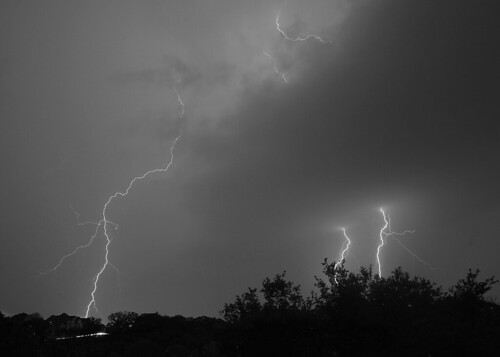Cool 2. How To images
Check out these 2. how to images:
How not to lock your bike

Image by kaputniq
How not to lock your bike – use 3 locks, 2 of which are hefty Abus ones locking the front wheel to the frame and the lock to the frame itself. Then put a £5 Halfords D-lock through the frame and around a 7 foot pole with nothing stopping the unerterprising thief just lifting the bike over the pole and carrying it away to contemplate how to remove the Abus locks in peace and privacy
How to Take Lightning Shots

Image by longhorndave
I get asked how to capture lightning shots a lot. Here is a little tutorial:
Recommended Equipment:
1. Camera that will let you use the "bulb" shutter setting and still set the aperture separately.
2. Good heavy tripod
3. Cable release (to remotely trip the shutter and hold it open)
4. Wide angle lens (17mm is what I usually use)
5. Watch with a second hand you can see in the dark.
Technique:
1. Setup your camera/tripod in an area it can’t get wet. Use a lens hood if your lens has one.
2. Set your focus to manual and focus the lens at infinity. Use your markings on the lens as a guide if it is too dark to see through the lens.
3. Set your camera to manual mode for both shutter and aperture (usually the “m” setting on DSLRs).
4. Set the shutter speed to “Bulb”. That is the mode where the shutter stays open for as long as you hold it open. It is imperative that you use a remote cable release for this so you don’t have to touch the camera while holding the shutter open.
5. Set your aperture around midway. If it is dark outside, I find an aperture of 13 works best for me. The goal is to set it so that you can open the shutter long enough (15 – 30 seconds) and get a good sky without it being too dark or too light.
7. Trip the shutter with the cable release and hold it for 15 to 30 seconds. It is best to time it with your watch so you can find the exact time with the best exposure.
8. Pray for a lightning strike while the shutter is open!
9. Close the shutter and view your result. If too dark, hold open longer, if too light shorten the time. You can also adjust the aperture if needed.
10. Repeat. Adjust, Repeat, Adjust, Repeat Adjust…..
A storm with not much lightning, you might have to take 50 to 100 empty shots before you get the lightning. A storm like last night, I was able to capture lightning on every other try—sometimes with two or three different lightning strikes in one exposure.
Tip: If lightning goes off 5 seconds into the exposure, don’t be tempted to close the shutter and look at it. Still keep exposing at least for 80- 85% of the time you were targeting.
For instance, if you would normally time for 30 seconds, keep going for at least 25sec. A good lightning burst (or two if you are lucky) will lessen the total exposure time… but not as much as you think.
Post processing:
1. Convert to B&W using the channel mixer ( or apply image command).
The colors are usually minimal in the pic and the tint of the sky can come off kind of funky, so I usually convert to b&W using the green channel only. It will usually have the best contrast in the sky.
Play with the channel mixer in Photoshop. You may find red to be your best channel for foreground detail and green for sky. The blue channel will contain the majority of the noise and usually won’t be useful.
2. Use a high amount on the sharpening. I use an aggressive 200 to 500 on the amount in the "unsharp mask " filter with a radius of 1 and threshold of 5 to 10. Best to do this on a duplicate layer so if it is too much you can just lower the layer opacity.
Hope this helps. Looking to forward to seeing everyone else’s attempts.
Leave a Reply